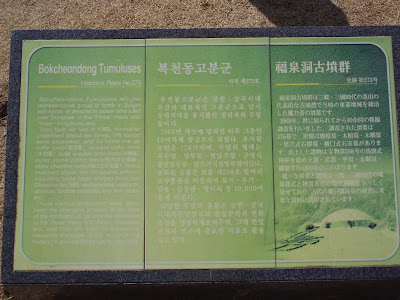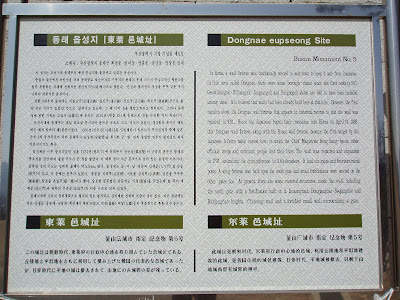Since arrival, I have yet to go anywhere for sightseeing, so I decided to venture out a bit. My plan was to go to Bokcheon Museum in Dongnae (동래 東萊), since every Saturday entry is free. I bought a 1 Day Subway Pass, and head straight to Myeongnyun-dong (명륜동 明倫洞). Apparently, 1st of March is the day of Independent Movement back in 1919. There was some event on Dongnae yesterday, but I did not go near it, just took a look from afar and turned back, as it was not within my plan for the day. Busan has a couple of museum, which you can see it from here. Check out this site first, if Korean is not your cup of tea.

There are a couple of historic site in around Dongnae as shown in the above map. Dongnae was the seat of the magistrate, thus the centre of the town was at Dongnae, until the arrival of Japanese, which has moved the centre of town southwards to the present location.

My first stop was Bokcheon Museum (복천박물관 福泉博物館). The museum displays artifacts about archaeological excavation around the area, especially on ancient tomb which is just right outside the museum on an open pavilion. Although there are brochures in English, Chinese, Japanese and Korean, most information board inside the museum is in Korean only. There are various form of tomb, which some is explained in detail the steps to create such formation in diorama.



I think the first information board is rather old, since the English portion can easily qualify for The Star's Boob Watch. The actual site of the tomb is currently marked with bushes. If you wish to see the on site tomb, there is one glass dome structure in the middle of the open pavilion to showcase how does it look like.




Not too far from the museum, there is the old Dongnae Fortress. It was one of the large fortress in those days, and the location for such fortress is rather good since it has four hills around it to provide a natural protection. Some fortress gates are restored while some are permanently gone. There is a small museum near to north gate that explains how the fortress was built. Well, here are the pictures.




Once you step into the museum, you will see a famous quote which is constantly repeated inside the explanation within the museum. It was on the wall in the entrance as well.
戰則戰矣 不戰則假我道First line is by the Japanese troop, saying "If you want to fight, fight, if not, then move out of the way". The response by Korean Song Sang Hyeon was "It's easy to die in a battle, but it's difficult to let you through". Since this museum was set up not too long ago, it has English explanation on the information board, but the very interesting video presentation is in Korean only.
戰死易 假道難


After understanding the story in museum, you can opt for going up to one of the watch tower on top of the hill. See from the picture above, there was where I went, Bukjangdae (북장대 北將臺), which is situated on Jeung Mountain (증산 甑山). If you can't see clearly the wooden structure as shown above, you probably can guess how high was it. At the peak, the view of Busan was rather good. Here's the watch tower and beneath it, is the view of Busan and also the ancient tomb at the bottom.

Anyone of you familiar with Busan Asian Games 2002 will notice the stadium from this view. Also from the top, you can see the Gwangan Bridge. It is also one of the reason why the fortress was built there as it is near to Nakdong river and close to the sea.


Since the day I went was 1st of March, I took the opportunity to take a photo with the Independence Movement Memorial near to Bukjeongdae. Also, there is a really nice exercise park next to the memorial, so if anyone of you cannot afford fitness centre fees, you can have a lot of exercise equipment up there.

Here are some of the places I have visited on the same day as well. One interesting about the 40 steps stairs is that, after ascending to the top, that street is a whole street of printer, just like Jalan Brunei in KL.



A side note, the next day after my museum visit, I was in Dongnae area again, but this time is for the hot spring, which Dongnae is also famous for. Quite an experience if you haven't been into one that everyone is naked. Also, there is a duck bulgogi shop just right outside the hot spring place, which is not too bad, except for the long wait.

No comments:
Post a Comment